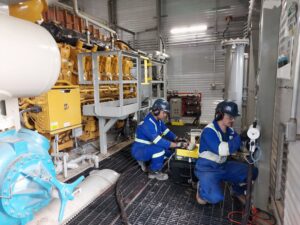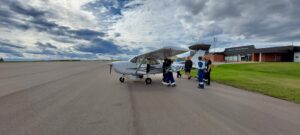National-Scale Methane Census
Projects Sponsor
For years, Canada’s climate policy had to rely on crude, slow-to-update estimates of methane emissions which significantly impeded mitigation efforts. Carleton University’s Energy & Emissions Research Lab (EERL) launched the National-Scale Methane Census to close this critical gap, ultimately helping Canada become the first country in the world to successfully incorporate aerial measurements into official IPCC reporting. Combining extensive aerial surveys, controlled release testing, and on-site measurements, EERL developed and published ground-breaking analytics to synthesize spatiotemporal data at a national scale. This has produced transformational insights into the magnitudes, distributions, and evolution of sources driving emissions while creating a measurable path to reaching Canada’s 2030 climate goals.
Aggressively reducing methane emissions is the most immediate action we can take to slow global temperature rise. Canada, now a co-convener of the Global Methane Pledge, has committed to reducing its oil and gas methane emissions by at least 75% by 2030. Success in achieving this is, however, contingent on accurate and consistent measurements to track evolving emission patterns and drive verified reductions.
Effective mitigation requires a deep understanding of emission sources, their distributions and variability, and the uncertainties associated with detection technologies, measurement methods, and implementation protocols.
Historically, Canada has had to rely on outdated and often simplistic estimates of national methane emissions for official greenhouse gas reporting; the gaps and inaccuracies of this approach have severely hampered policy development and to date have impeded any real progress in reducing emissions.
These challenges are echoed internationally where in 2022 the Intergovernmental Panel on Climate Change (IPCC) launched dedicated efforts to explore how atmospheric observations data could be integrated into official emissions inventories.
This Energy & Emissions Research Lab project—a collaborative effort made possible with support from the British Columbia Government, Natural Resources Canada, Environment & Climate Change Canada, and The United Nations Environment Program’s International Methane Emissions Observatory—was launched in direct response to this urgent need. It seized the opportunity to demonstrate Canadian leadership internationally.
A key goal was to develop and implement new replicable protocols that could create national-scale methane inventories using direct measurements not just estimates. The ultimate objective was to provide comprehensive, timely, and accurate insights into the true magnitudes and distributions of methane sources in the upstream oil and gas sector which could drive mitigation, inform evidence-based regulations, and successfully track emissions reduction over time.
 The project built on a decade of background research and exploratory studies by EERL, including small scale aerial measurement trials, off-site ground-based measurements, developing and testing novel laser-based measurement technologies, in-field controlled release testing, targeted on-site measurements to understand key sources, and preliminary aerial surveys.
The project built on a decade of background research and exploratory studies by EERL, including small scale aerial measurement trials, off-site ground-based measurements, developing and testing novel laser-based measurement technologies, in-field controlled release testing, targeted on-site measurements to understand key sources, and preliminary aerial surveys.
This body of work ultimately led to the publication of a pioneering analytic protocol for creating comprehensive measurement-based methane inventories that intelligently combines large-scale aerial-and-ground-based measurement data while considering real-world probabilistic detection sensitivities.
This groundbreaking approach was shared internationally in an invited presentation to the United Nations Intergovernmental Panel on Climate Change (IPCC) Task Force on Inventories in Geneva in September 2022 which marked the first-ever introduction of a formalized method for directly incorporating aerial measurements into official methane inventories. This world-leading methodology was the foundation for the National Scale Methane Census.
The National Scale Methane Census comprised five distinct phases which combined to reach the goal of producing the first comprehensive measurement-based insights into the sources driving Canada’s oil and gas sector methane emissions while enabling improved regulations and measurable reductions.
Phase 1, Census Planning, involved meticulous analysis of facility and well data satellite imagery and infrastructure records across Canada’s three dominant oil and gas producing provinces. Following careful identification and geolocation of thousands of active facilities and well sites, a statistically representative stratified sample was created for subsequent aerial surveys.
Phase 2, Aerial Measurements, involved, as one might guess, comprehensive aerial surveys. Over ~15000 distinct sites throughout Western Canada, where each site could contain multiple separately identified facilities and/or wells, were surveyed. The surveys launched in summer 2023 and were completed using Bridger Photonics’ advanced Gas Mapping LiDAR (GML) technology that had undergone extensive independent testing and field validation by their lab. The GML technology detects and quantifies methane plumes at high resolution. Each facility was scanned with overlapping passes and follow-up flights were conducted to refine quantification and assess emission persistence.
 Phase 3, Ground Investigations, included targeted source measurements to complement aerial measurements, providing critical validation and capturing sources undetectable by aircraft. The groundwork included inventorying of major equipment, detailed counts of gas-driven pneumatic instruments and direct measurements of methane slip from compressors, storage tanks and catalytic heaters.
Phase 3, Ground Investigations, included targeted source measurements to complement aerial measurements, providing critical validation and capturing sources undetectable by aircraft. The groundwork included inventorying of major equipment, detailed counts of gas-driven pneumatic instruments and direct measurements of methane slip from compressors, storage tanks and catalytic heaters.
Phase 4, Data Analysis and Source Attribution’ focused on manually linking aerially detected emissions to specific sources equipment and facility types followed by rigorous statistical modeling and analysis to estimate source rates within precisely defined 95% confidence limits and finally, Phase 5, ‘Inventory Development’, produced a hybrid measurement-based source-level methane inventory for 2023. This enabled year-over-year comparison against previously measured benchmarks with findings disseminated to government industry and academic stakeholders through direct presentations, reports, and peer-reviewed publications.
All phases of the project highlight a terrible reality of the fight against climate change and that is that the climate you must work in, and for, is changing. The worsening effects of climate change itself make working to mitigate it much harder. The unprecedented and devastating forest fires of 2023 across Western Canada are a direct consequence of a warming climate, drier conditions, and shifting seasonal patterns. These fires only intensify over the years and not only threaten local communities and ecosystems but also severely disrupt the very work needed to mitigate emissions.
Given the seasonal nature of aerial and ground-based methane measurements, which can only be conducted during warmer months, this posed significant logistical challenges requiring constant adaptation and contingency planning.
Smoke, no-fly zones, and safety concerns caused delays or required last-minute changes in flight plans while ground teams faced access restrictions, road closures, and hazardous conditions. The vast geographic spread of oil and gas operations across multiple provinces provided some flexibility in completing parallel surveys in less affected areas and ultimately allowed completion of all planned surveys over extended timelines.
These challenges underscore the urgency and relevance of the work EERL is doing. The new and quantitative insights that emerged from this research are now informing regulatory development, driving industry, mitigation action, and inspiring similar work in other sectors and countries.
These innovative made-In-Canada protocols have garnered international recognition and are now being adopted, imitated, and replicated internationally through an active partnership with United Nations Environment Programme International Methane Emissions Observatory (UNEP IMEO) further amplifying the impact of this work.
National-Scale Methane Census have helped information on the state of methane mitigation efforts reach diverse stakeholders including industry, federal and provincial governments, academia, the Canadian public and international partners, passing emission data on to those who need it most.













